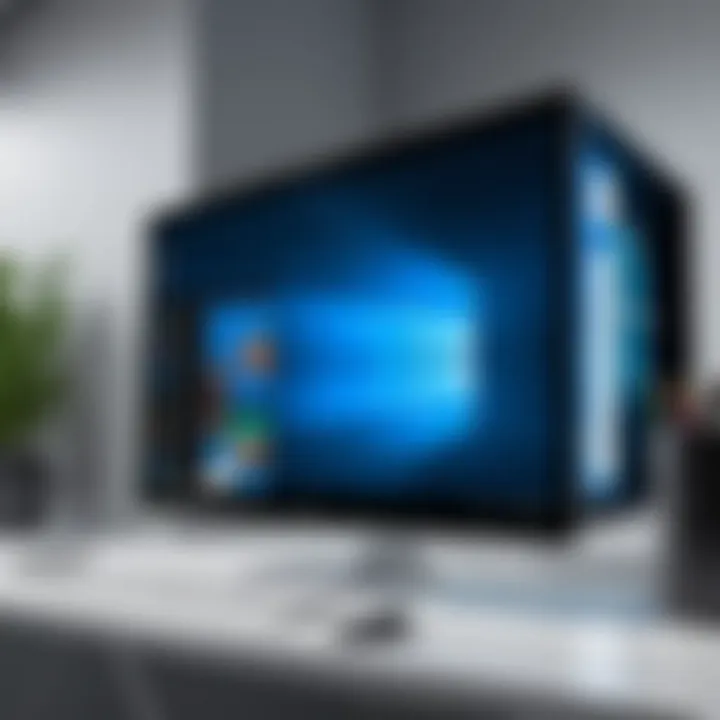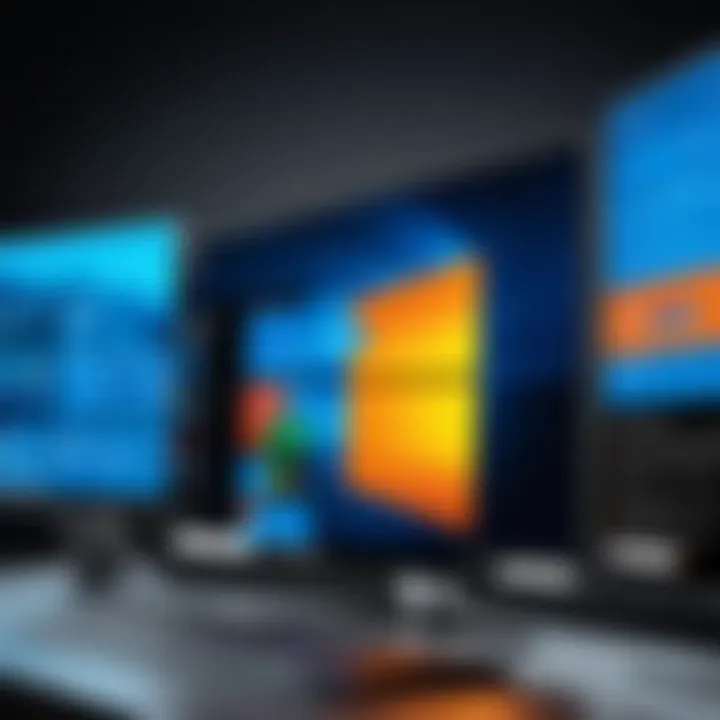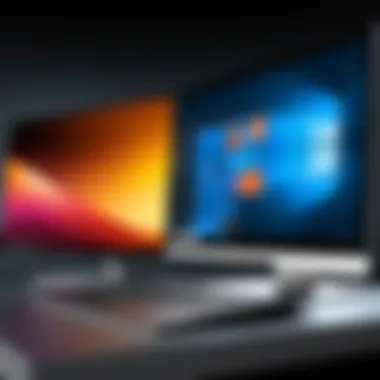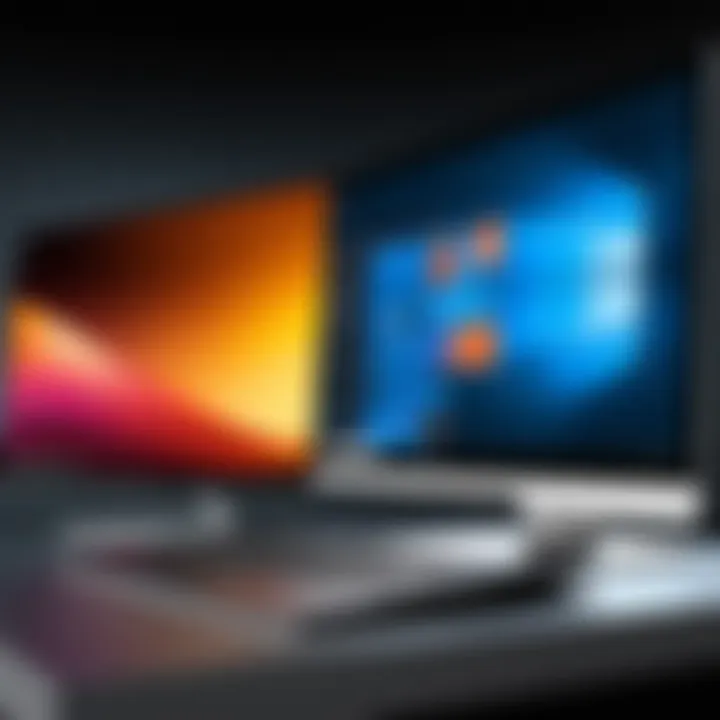Maximizing Windows 10 Performance on Your Computer


Intro
Optimizing Windows 10 can sometimes feel like rearranging the deck chairs on the Titanic. Many users, especially IT professionals and tech enthusiasts, may find themselves grappling with occasional lags and unresponsive applications. With the growing demands of modern software, knowing how to fine-tune your Windows 10 installation is crucial for a seamless experience.
In this guide, we will explore various techniques to enhance the performance and usability of Windows 10 tailored for specific computer configurations. Readers will learn about system requirements, installation tips, and performance tweaks that can significantly impact productivity. Each section will provide insights into making the most of your system while troubleshooting common issues that may arise.
By the end of this article, you will be armed with knowledge to customize your Windows 10 settings, improving not just speed but also overall satisfaction with your computing experience. Let's dive deeper into the world of system performance.
Understanding Windows
Understanding Windows 10 lays the groundwork for optimizing each computer running this operating system. It's crucial to grasp the key features, system requirements, and editions available to ensure users can tailor their experience effectively. Windows 10 has become a dominant player in the operating system market, thanks to its versatility and broad application across various hardware configurations.
Familiarity with Windows 10 allows users, especially IT professionals and tech enthusiasts, to identify performance bottlenecks and effectively manage system resources. Knowledge of core aspects such as system requirements helps in planning for upgrades and ensuring compatibility, while understanding different editions assists in making informed choices that fit individual or organizational needs. Let's delve into some patterned elements that set Windows 10 apart.
Overview of Windows Features
Windows 10 is packed with an array of features designed to improve user experience and productivity. Notably, features such as the Start Menu, Cortana, and Windows Store provide a blend of accessibility and functionality.
- The Start Menu merges elements from both traditional Windows and modern tile interfaces, offering users a comprehensive view of both applications and system tools.
- Cortana, Microsoft’s digital assistant, helps streamline daily tasks, whether it's setting reminders, conducting web searches, or providing timely information about weather and news.
- The Windows Store grants users access to a plethora of applications, making it easier to find tools that enhance productivity.
These features together contribute significantly to a better overall experience, making it easier for users to optimize their workflows.
Core System Requirements
To effectively run Windows 10, familiarity with the core system requirements is paramount. Insufficient hardware can lead to suboptimal performance and frustrations. Here's a look at the minimal and recommended system requirements:
- Processor: 1 GHz or faster compatible 64-bit processor
- RAM: 1 GB for 32-bit or 2 GB for 64-bit
- Hard Disk Space: At least 16 GB for 32-bit or 20 GB for 64-bit
- Graphics Card: DirectX 9 or later with WDDM 1.0 driver
- Display: 800x600 resolution
Understanding these specifications ensures users can prepare their systems adequately, avoiding complications post-installation. This comprehension leads to more efficient optimization by establishing a baseline for performance expectations.
Editions of Windows and Their Uses
Windows 10 comes in several editions, each designed to cater to varying use cases. Here we focus on three major editions to highlight the distinct features and advantages they offer.
Home Edition
The Home Edition is tailored for general consumers and is known for its user-friendly characteristics. With essential features like Windows Hello for secure sign-in and Microsoft Edge browser, it's suited for everyday activities such as browsing and entertainment. Its simplicity makes it a popular choice among casual users.
- Key Characteristic: Designed for home users, supporting all basic features without the complexity of management tools.
- Unique Feature: The inclusion of Cortana enhances personal productivity.
- Advantages: Affordability and all necessary functionalities for average users.
- Disadvantages: Lack of advanced features like Group Policy Management can be limiting for power users or small business applications.
Pro Edition
Pro Edition takes it a step further, catering predominantly to professionals and small businesses. It comes equipped with features that enhance productivity and security, including BitLocker for disk encryption and Remote Desktop capabilities.
- Key Characteristic: Enhanced security and management features tailored for business needs.
- Unique Feature: The ability to join domain networks makes it suitable for business operations.
- Advantages: Ideal for users requiring sophisticated functionality, greater security, and control.
- Disadvantages: Can be relatively costly for home users who do not need its features.
Enterprise Edition
Enterprise Edition is designed for large organizations, featuring advanced security and device management capabilities. Features like DirectAccess and Microsoft Application Virtualization are designed to streamline IT management within enterprises.
- Key Characteristic: Focused on large deployments and providing robust management capabilities.
- Unique Feature: Advanced analytics and cloud integration strategies prove invaluable for enterprise-scale environments.
- Advantages: Superior security and efficiency enhancements for businesses.
- Disadvantages: Complexity in setup may discourage individual users or smaller teams.
Understanding these distinct editions of Windows 10 is crucial for selecting the right version for specific needs. This nuanced comprehension enhances the optimization process by aligning system functionalities with user requirements.
Installing Windows
Installing Windows 10 is a critical step towards optimizing your computer's performance. The installation process sets the foundation for how well your system will run, directly impacting everything from speed to stability. It’s not just about slapping on an operating system; it’s about ensuring that your machine runs efficiently from the get-go. A well-executed installation can save you from future headaches caused by poor configurations or incompatibilities down the road. In this section, we will navigate through important considerations and detailed steps to achieve a seamless installation.
Preparing Your Computer for Installation
Before diving headfirst into the installation of Windows 10, it’s vital to prep your computer. Think of this phase as gathering your tools before starting a home improvement project. Here are some key points to keep in mind:
- Backup Your Data: Always backup your files before changing your operating system. You don’t want to risk losing important documents or photos. Utilize an external hard drive or cloud storage for this.
- Check System Requirements: Ensure your machine meets the necessary requirements for Windows 10. Essentially, you need to have at least 1 GHz processor, 2 GB RAM for the 64-bit version, and a minimum of 20 GB of free disk space.
- Update Your BIOS: Sometimes, an outdated BIOS can lead to issues during or after the installation. Make sure to check for any available updates from your motherboard manufacturer.
- Create a Windows 10 Installation Media: This can be done using a USB drive or DVD. It’s essential to have this media ready, as it acts as the gateway into the new OS.
By following these preparatory steps, you set yourself up for success, avoiding potential pitfalls that might arise during installation.
Choosing the Correct Installation Media
The choice of installation media can significantly affect installation speed and convenience. In this day and age, going for a USB flash drive is generally preferred due to its speed and ease of use. Here are a few options:
- USB Flash Drive: This is typically the best option. Use at least an 8GB flash drive and format it using FAT32. Windows Media Creation Tool can easily assist in creating this bootable drive.
- DVD: While DVDs are becoming somewhat antiquated, they can still be used for installation if no other options are available. Keep in mind, it may take longer to complete the installation via DVD.
- Network Installation: This is often more relevant for corporate settings. In personal use, it might be too complex unless you are comfortable with advanced networking.
Choosing the right media not only makes the installation faster but also smoother, ensuring you have a reliable method to install Windows 10 without interruptions.
Step-by-Step Installation Process
Now that you’re prepared and have your installation media sorted, it’s go time. Below is a straightforward procedure for installing Windows 10:
- Insert Installation Media: Plug your USB drive or insert the DVD into your computer.
- Boot from the Media: Reboot your computer and enter the BIOS/UEFI settings to prioritize booting from the installation media. This might vary depending on your motherboard.
- Windows Setup: Once booted, the Windows Setup screen should appear. Select your language, time, and keyboard preferences, then click "Next."
- Install Now: Click on the "Install Now" button. Accept the license terms when prompted.
- Choosing Installation Type: You’ll need to select between upgrade or custom installation. If you're starting fresh, it's better to go for custom.
- Partitioning Your Disk: Here, you'll select the hard drive where you want to install Windows 10. If no partition exists, create one. You might consider deleting existing partitions if you want a clean slate but ensure you back up critical data first.
- Installation Progress: Windows will now start installing. This can take some time, so be patient. It will reboot several times during the process.
- Personalization: After installation, you'll go through steps to personalize your Windows experience, including setting up accounts, privacy settings, etc.
Remember: The installation process might vary slightly depending on your hardware and existing OS, but following this guide will cover most standard setups.
Getting through the installation is a significant milestone. Take your time, ensure each step is followed carefully, and soon you'll find yourself diving into a world of optimized performance with Windows 10.
Post-Installation Setup
Setting up your Windows 10 system post-installation is akin to laying the groundwork for a sturdy house. While the installation process gets the system up and running, the post-installation setup is where you fine-tune the environment to suit your specific needs. This phase is not merely a formality; it is critical for achieving optimal performance, security, and usability of your device.
When we talk about post-installation setup, we’re looking at several important points. First off, it’s about ensuring that the initial configuration aligns with your preferences. Consider it your first opportunity to express how your computer should behave and what kind of experience you want from it—whether it’s for work, entertainment, or both.
Secondly, this stage helps in enhancing security by adjusting settings that will keep your system protected from various cyber threats. Lastly, a proper setup can save time down the road. Incorrect configurations can lead to frustration and inefficiency, which nobody wants when they are trying to brush up on productivity.


Initial Configuration Settings
The initial configuration settings is where the magic starts. After Windows 10 installation, you’re welcomed with a series of questions that will help tailor the setup to your preferences. These might include selecting your desired region and language or agreeing to the terms of service.
One key setting to consider is whether to enable or disable location services. Some users appreciate the convenience of having their location detected for weather apps, while others prioritize privacy. Note that this may impact applications that may gather location information.
Additionally, disabling Cortana, if you're not planning to use it, can help in freeing up system resources. Cortana may seem convenient, but it runs in the background and can affect performance slightly. Every setting counts, ensuring that your machine runs like a well-oiled machine.
Connecting to the Internet
Establishing an internet connection might look straightforward, yet it often causes hiccups for many users. It seems simple, just choosing a Wi-Fi network and entering a password. However, a stable connection can be crucial for downloading updates and accessing cloud services that nearly every modern user relies on today.
Here’s a way to approach this:
- When connecting to a Wi-Fi network, select the one that matches your home or work environment. Make sure it’s a secure connection, preferably one that requires a password.
- For better security, consider using a Virtual Private Network (VPN) to safeguard your online activities from prying eyes, particularly when you’re connected to public networks.
- If using Ethernet, ensure that the cable is properly connected and that the router is functioning as it should, to provide a stable internet connection.
Creating User Accounts
Creating user accounts on your Windows 10 system is a vital step, especially in a shared environment. It allows family members or colleagues to have individual profiles customized to their liking, while preventing them from accidentally messing up your settings.
When setting up user accounts, you have the choice between two prominent options:
- Local Account: Good for standalone use. It’s a traditional way to keep your data private, without cloud syncing.
- Microsoft Account: This is linked to your email and provides more features, such as syncing settings across devices, accessing OneDrive, and downloading apps from the Microsoft Store easily.
"Herding cats might be easier than managing multiple user settings in a single account, so keep your accounts distinct."
Performance Optimization Techniques
Performance optimization techniques are crucial for ensuring that your Windows 10 computer operates smoothly and efficiently. The importance of these techniques cannot be overstated, especially for users who rely on their systems for demanding tasks such as graphic design, software development, or heavy multitasking. By implementing various strategies, users can experience faster load times, enhanced responsiveness, and reductions in lag.
Updating Drivers and Software
Keeping drivers and software up-to-date is one of the simplest yet most effective ways to optimize performance. Drivers act as communication bridges between your operating system and hardware components. Outdated drivers can cause crashes, slow performance, or even hardware malfunctions. Here’s how to keep them fresh:
- Check Device Manager: You can access Device Manager by right-clicking the Windows icon and selecting it from the list. Look for any devices with a warning sign, which indicates an issue.
- Use Automatic Update: Windows 10 often does a good job updating drivers automatically, but it's worth checking this feature by navigating to Settings > Update & Security > Windows Update.
- Manufacturer Websites: Sometimes, the most recent drivers are only available on the manufacturer’s website. Visit the support page of your device’s brand to download the latest drivers.
Keeping your software updated is equally vital. Software updates not only fix bugs but also include performance enhancements. Regularly check for updates in applications, especially those that are resource-intensive.
Customizing Visual Effects
Windows 10 is known for its attractive visual effects, but these features can consume valuable resources. Tailoring these effects can lead to noticeable performance gains. To do this:
- Open Performance Options: Type "Performance" in the search bar and select "Adjust the appearance and performance of Windows."
- Choose Minimal Effects: Select "Adjust for best performance" to disable all special effects or manually choose which effects to keep. For a balance, you might want to keep a few aesthetic features while turning off the rest.
Customizing these settings can give your computer a faster feel, especially when running older or resource-heavy hardware.
Managing Startup Programs
Over time, many applications add themselves to your startup list without you even realizing it. This can lead to sluggish boot times and increased memory usage. Managing these programs is simple:
- Open Task Manager: By right-clicking the taskbar and selecting "Task Manager," you can access the Startup tab.
- Disable Unnecessary Apps: Review the list of programs that launch on startup. If you see applications you rarely use, consider disabling them. Just right-click the program and select "Disable."
Doing this can provide a noticeable improvement in boot time and overall system responsiveness.
Using Built-in Troubleshooting Tools
Windows 10 comes with several built-in troubleshooting tools that can help identify and resolve performance issues. Some tools to leverage include:
- Troubleshoot Settings: Go to Settings > Update & Security > Troubleshoot to access various troubleshooters. For example, running the "Performance troubleshooter" can pinpoint problems and offer solutions.
- Windows Memory Diagnostic: If you suspect a memory issue, type "Windows Memory Diagnostic" into the Start menu search. This tool will check for memory problems that could be hindering your performance.
- Disk Cleanup: Another useful built-in tool, accessible via the Start menu, will help you clean up unnecessary files taking up space on your hard drive. Select your system drive, and it will calculate what can go.
Utilizing these built-in solutions can significantly ease the burden when dealing with common performance hiccups, leading to a smoother experience.
System Maintenance Practices
System maintenance is the backbone of keeping your Windows 10 experience smooth and reliable. Just like a car needs regular oil changes and tire rotations to run properly, your system requires periodic upkeep to ensure it runs efficiently. Neglecting routine maintenance can lead to sluggish performance, software conflicts, and even data loss. This section dives into essential practices that help maintain your system's health and uplift performance over time.
From updates to cleaning and defragmentation, each practice contributes significantly. The benefits extend from improved speed to enhanced security, shielding your device from potential vulnerabilities. Additionally, incorporating maintenance into your regular routine ensures that your system remains in peak condition without major disruptions.
Regular Updates: Importance and Process
Keeping your system updated is not just a good practice; it’s a necessity. Regular updates from Microsoft provide essential security patches, bug fixes, and sometimes even new features that can enhance your system’s functionality. Not keeping these updates in check can leave your computer exposed to malware attacks, or worse, incompatible software performance.
The process is straightforward:
- Navigate to Settings: Click on , then the gear icon for Settings.
- Go to Update & Security: This tab allows you to view your update status.
- Check for updates: Windows will automatically search for any new updates and present them for installation.
- Schedule updates: To avoid disruptions, consider scheduling updates during off-hours.
It's wise to set notifications for important updates so you aren't left in the dark about your system's security.
Disk Cleanup Procedures
Over time, your system accumulates junk files, old backups, and temporary files that clutter your drive. This buildup can slow down your computer and waste valuable disk space. Disk cleanup is an essential procedure to reclaim that space and optimize performance.
To perform disk cleanup:
- Search for Disk Cleanup: Type "Disk Cleanup" in the search bar.
- Select the drive to clean: Usually, this is the C drive.
- Choose files to delete: You can select unnecessary files such as system restore points, temporary Internet files, and recycle bin contents.
- Confirm and remove: Hit OK, and confirm the deletion.
For extra measure, consider using tools like CCleaner, which help automate and streamline this cleanup process.
Defragmenting Your Hard Drive
If your system runs on a traditional hard drive (HDD), defragmentation is a crucial maintenance step. Your files can become scattered across the drive over time, leading to increased loading times and slower performance. Defragmentation brings those pieces back together, thus optimizing access speed.


Here’s how to defragment your hard drive:
- Open the defragment tool: Search for "Defragment" from the start menu and select "Defragment and Optimize Drives."
- Select the drive: Choose the drive you want to defragment, typically the C drive.
- Click Optimize: The software will analyze and reorganize the files for faster access.
For solid-state drives (SSDs), this process isn’t as necessary, but keeping your drive uncluttered through regular cleanup is still important.
Regular maintenance practices not only enhance performance but can also prolong the lifespan of your Windows 10 system, ensuring it stays reliable in the long run.
Incorporate these system maintenance practices into your routine. They are your ticket to a seamless Windows experience, giving you peace-of-mind as you navigate your tasks.
Troubleshooting Common Issues
In any computing environment, users will eventually face problems that impede the smooth operation of their systems. Understanding how to address these common issues is crucial for maintaining optimal performance on Windows 10. Whether you are managing a single device or a fleet of computers, effective troubleshooting techniques can reduce downtime, improve productivity, and enhance user satisfaction. This section explores specific common issues and equips IT professionals and tech enthusiasts with the insights needed to identify, diagnose, and resolve them efficiently.
Identifying Performance Bottlenecks
When a computer starts to lag or is sluggish, the root cause often lies in performance bottlenecks. These bottlenecks can arise from various sources—be it hardware limitations, resource-heavy applications, or bloated background processes. Identifying these bottlenecks is the first step in remedying the situation.
To begin, open the Task Manager by right-clicking on the taskbar and selecting Task Manager. This tool gives you an overview of what is happening in your system, including CPU usage, memory consumption, and disk activity. Here are some tips to pinpoint performance issues:
- Look for applications that are consuming excessive CPU or RAM. If a particular app is frequently at the top of the list, it may be poorly optimized or outdated.
- Check disk usage; if the disk usage is consistently near 100%, this might indicate that your hard drive is under stress.
- Monitor network activity as well, evaluating if any programs are hogging bandwidth.
Once identified, consider whether an upgrade, optimization, or even removal of problematic software is the right path forward.
Resolving Software Conflicts
Software conflicts can manifest surprisingly, leading to various problems, including crashes and freezing. These conflicts might occur due to incompatible programs, overlapping functionalities, or even mis-managed dependencies. Resolving these issues promotes a stable user experience.
To troubleshoot conflicts:
- Update all software: Keeping your applications up-to-date can rectify compatibility issues and provide security patches.
- Isolate the problem: Try running your applications one by one. If a particular app causes instability when running alongside others, you may have found the culprit.
- Uninstall conflicting software: In some cases, it may be necessary to remove an application that you seldom use, especially if it has a known history of conflicts with other tools.
- System Restore: If issues arose after a recent update, consider rolling back the system to a previous state through System Restore.
Fixing Network Connectivity Problems
Network issues can be a headache, whether they stem from hardware issues, software settings, or external factors like service outages. Reliable internet connectivity is crucial, especially in today's remote work environment.
Begin troubleshooting your network by:
- Checking physical connections: Ensure all cables are secure and that your modem and router are powered and functioning.
- Running the Network Troubleshooter: Windows 10 has built-in tools for troubleshooting. Navigate to Settings > Update & Security > Troubleshoot > Additional troubleshooters > Internet Connections and run the troubleshooter.
- Resetting the network adapter: Sometimes, simply disabling and re-enabling your network adapter can resolve connectivity issues.
- Checking firewall settings: Occasionally, strict firewall settings prevent connections. Verify that your firewall isn't blocking desired connections by checking your settings in Windows Security.
Tip: You can reset your adapter by navigating to Settings > Network & Internet > Status > Network reset. This will remove and reinstall network adapters.
In wrapping up, these troubleshooting techniques allow for a structured approach to common issues faced on Windows 10 systems. By addressing performance bottlenecks, software conflicts, and network connectivity problems, users can create a seamless and effective computing environment.
Advanced Configuration Options
Optimizing Windows 10 isn't just about surface-level tweaks; it's about diving deep into the operating system's inner workings. Advanced configuration options play a crucial role in this process. For those who are tech-savvy or delving into IT, these features provide a pathway to fine-tuning and enhancing overall performance, security, and user experience. From setting policies that govern the user environment to executing complex commands, understanding these options equips one with the tools needed to tailor Windows 10 to specific needs.
Group Policies and Configurations
Group Policies serve as a powerful mechanism for managing computer systems in a networked environment. On a local level, administrators can forge rules that dictate how users interact with their devices. The importance of this cannot be overstated, especially in professional settings where maintaining consistency and security is paramount. Here are a few key points pertaining to Group Policies:
- User Restrictions: Set limitations on what users can do. This might range from restricting access to certain software to limiting changes in system settings.
- Software Management: Tools can be deployed automatically to users, ensuring that everyone has the necessary applications without manual installation.
- Security Configurations: Policies can enforce password strength, control security updates, and manage network access, bolstering the overall security posture.
By using the Group Policy Editor, which can be accessed by typing in the Run dialog, users can explore the myriad settings available, tailoring them to their needs appropriately.
Registry Tweaks for Efficiency
Now, the Windows Registry is often viewed with a mix of respect and apprehension. This integral part of the operating system acts like a database for configuration settings. A few selective tweaks can lead to noticeable improvements. Here are some pointers for optimizing through the Registry:
- Disabling Unwanted Services: Navigate to . Here, unnecessary services can be disabled, which might free up valuable system resources.
- Enhancing Performance: Modify values in to adjust settings that control the visual aspects of Windows, such as enabling "Use less RAM".
- Startup Configuration: Tweeking the entries related to startup programs can help minimize boot times, ultimately speeding up access to a user’s desktop.
A word of caution: Always back up the Registry before making changes. One wrong move can lead to severe operational issues.
Using Windows PowerShell for Automation
PowerShell offers a versatile command-line interface for Windows that empowers users to automate tasks and manage system configurations efficiently. With its scripting capabilities, PowerShell is the go-to choice for IT pros looking to streamline repetitive tasks, saving both time and effort. Key aspects include:
- Task Automation: Write scripts to automate regular maintenance tasks, such as updates and cleanup, allowing more time for strategic initiatives.
- System Monitoring: Custom scripts can be developed to gather performance metrics from various applications, providing real-time insights into resource utilization.
- User Management: Admins can manage users, groups, and permissions easily, making it an essential tool for managing multiple accounts.
Here’s a simple command to check the system health:
This will provide users with a snapshot of system details, which can be useful when considering upgrades or troubleshooting.
"Harnessing advanced configurations can transform your Windows experience from ordinary to extraordinary. The only limit is how far you wish to delve into the technical intricacies."
In summary, understanding advanced configuration options in Windows 10 allows for a tailored experience, especially when one seeks to maximize efficiency and performance. It’s not merely about what is visible on the surface; the real power lies in navigating the settings that truly empower and optimize system operations.
Customizing Windows Experience
Customizing the Windows 10 experience is a crucial aspect for many users, allowing them to tailor their operating system according to personal preferences, work requirements, or even aesthetic choices. Such customization leads to increased productivity, as individuals can streamline their workflows and access frequently used applications more efficiently. Additionally, the look and feel of your environment can significantly influence your mood and how you interact with the device, making personalization an essential consideration for a satisfactory user experience.
Personalizing the Start Menu and Taskbar
The Start Menu and taskbar are at the heart of navigation on Windows 10, and personalizing them can lead to a smoother, more intuitive experience. Here’s how customizing these elements can help:
- Pinning Important Apps: Users can pin their most-used applications directly to the taskbar for quick access. This eliminates the need to sift through multiple menus. For instance, if you frequently use applications like Microsoft Word, your email client, or a web browser, having these at your fingertips can streamline your daily activities.
- Group and Organize Tiles: The Start Menu allows users to group tiles into folders. This method can minimize clutter and aid in quickly locating specific applications, ultimately enhancing organization and efficiency.
- Resizing and Moving Tiles: Personal preference plays a significant role in how users visualize their workspace. Windows 10 enables individuals to resize and move tiles as they see fit. Whether it’s adjusting the size of a tile for a frequently used app or relocating it to a more visible area can contribute to user comfort and productivity.
"A tidy Start Menu is like a clear desk – you can focus better."


Choosing Default Applications
Windows 10 comes with various pre-installed applications, but choosing default applications ensures that your most preferred tools are utilized seamlessly. Here are some factors to consider:
- Setting Default Applications for File Types: Users can set specific applications to automatically open certain file types. For example, you may prefer to open PDF files in Adobe Reader rather than the built-in Edge browser. This can improve your workflow efficiency and provide a better user experience with your chosen applications.
- Web Browser Preferences: Opting for a default web browser can also affect how you interact with online content. Switching to browsers like Chrome or Firefox, instead of the default Microsoft Edge, can enhance overall browsing speed and capabilities.
- Changing Music and Video Playback Apps: Different applications offer various features and user experiences. Selecting your preferred media player can enhance your enjoyment when consuming content, giving you control over your media landscape.
Setting Up Virtual Desktops
Creating virtual desktops on Windows 10 offers an innovative way to manage multiple projects or tasks simultaneously. This feature is particularly beneficial for users who juggle various responsibilities or need to maintain focus on specific tasks:
- Dedicated Workspaces: Users can create separate desktops for work and personal use, allowing for distraction-free environments. Switch between desktops with ease — one for meetings, another for personal browsing.
- Improving Focus: By distributing tasks across different virtual desktops, users can achieve a cleaner mental slate. A desktop wholly devoted to work-related applications eliminates distractions from personal apps.
- Quick Navigation: Accessing and switching between virtual desktops is straightforward. Just use Windows + Tab to view all desktops and shift focus instantly.
By customizing these elements of Windows 10, users can cultivate an efficient working environment that reflects their specific needs and style. Tailoring your experience not only enhances functionality but also fosters a sense of ownership and comfort in your daily digital interactions.
Ensuring Security on Windows
In today’s digital world, the importance of security on Windows 10 cannot be overstated. Cyber threats are proliferating, with malicious software and hackers lurking around every corner. This section emphasizes the need for robust security measures to protect your data, privacy, and the integrity of your system. By implementing effective security strategies, you not only safeguard your computer but also enhance productivity, allowing you to focus on your work rather than worrying about potential breaches.
Configuring Windows Defender
Windows Defender is a key component of Windows 10’s security framework. It acts as an antivirus and antimalware solution that is built into the operating system. Configuring Windows Defender effectively can provide substantial protection against various forms of malware without requiring third-party software.
- Enable Real-Time Protection: Ensure that real-time protection is activated. This feature allows Windows Defender to actively monitor your system for any suspicious behavior and threats as they occur.
- Run Regular Scans: Schedule periodic scans to evaluate your system for potential issues. Daily or weekly scans can help identify threats before they escalate.
- Update Definitions: Keep Windows Defender up to date. Threats evolve; therefore, having the latest definitions ensures that your system can combat new types of malware.
To access these settings, go to: Settings > Update & Security > Windows Security > Virus & Threat Protection.
Utilizing Built-in Firewall Settings
The built-in firewall within Windows 10 plays a vital role in securing your network and preventing unauthorized access. Proper configuration of the firewall settings can help protect your system from external threats while allowing you to manage which applications can communicate over the network.
- Check Firewall Status: Always ensure that your firewall is turned on. You can do this by accessing: Control Panel > System and Security > Windows Defender Firewall.
- Customize Your Rules: It’s beneficial to create custom rules for specific applications that you trust, ensuring they can run without hindrance while maintaining strict rules for unknown software.
- Monitor Connections: Use the built-in tools to review applications trying to access the internet. Block any that seem suspicious or unnecessary.
Best Practices for Safe Browsing
Safe browsing habits can significantly reduce the chances of encountering malware or phishing scams. Here’s how you can enhance your online safety:
- Use Secure Connections: Always ensure that the websites you visit use HTTPS. This adds a layer of security through encryption.
- Avoid Suspicious Links: Be wary of links in emails or social media posts from unknown sources. These can often lead to phishing sites or trigger downloads of malicious software.
- Keep the Browser Updated: Always keep your web browser updated to the latest version. Updates include security patches that protect against newly discovered vulnerabilities.
- Consider an Ad Blocker: Using an ad blocker can prevent malicious ads from displaying on your browser, giving you an additional layer of security.
By implementing these strategies, you’ll create a more secure environment for using Windows 10, ultimately ensuring that your personal and professional data remains confidential and secure.
Exploring Additional Features
In the realm of Windows 10, one can easily get lost in the complexities of system optimizations and performance tweaks. However, the exploration of additional features often gets overshadowed by the immediate concerns of functionality and speed. This section aims to shed light on the importance of these features, delving into tools and enhancements that not only improve efficiency but also enrich the overall user experience. Notably, integrating these features can streamline workflows and unlock capabilities that many users may be unaware of—just a small tweak here and there can make a significant difference.
Windows Subsystem for Linux
The Windows Subsystem for Linux (WSL) is a game changer for developers and system administrators alike. By providing a bridge between the Windows environment and Linux, WSL allows users to run a full-fledged Linux distribution directly on Windows without the overhead of a virtual machine or dual-boot setup. This not only fosters flexibility but also supports the use of Linux-first tools seamlessly.
Benefits of using WSL include:
- Easy Access to Linux Tools: Developers can run common command-line tools and utilities without switching systems entirely.
- Better Integration: Files can be shared across both ecosystems, simplifying tasks that require tools from both worlds.
- Performance: WSL runs at near-native speed, ensuring that developers have access to fast, responsive environments.
To set up WSL, all one needs to do is enable it through the Windows Features dialog and then install a preferred Linux distribution from the Microsoft Store. This quick setup can open a whole new realm of possibilities.
Using Cortana for Productivity
Many Windows 10 users underestimate the power of Cortana, Microsoft's digital assistant. While it may seem like a simple voice-activated tool, when utilized effectively, Cortana can significantly enhance productivity. From organizing schedules to setting reminders and fetching information, Cortana is like an extra pair of hands—only, this pair is always available at your beck and call.
Utilizing Cortana can streamline daily tasks by:
- Managing Tasks and Reminders: By verbally telling Cortana to take notes or set reminders, users can keep their hands free for other tasks.
- Quick Information Retrieval: Need to look something up? Simply ask Cortana to search the web or inquire about general knowledge.
- Integrating with Other Apps: Cortana works with various applications, allowing for a more comprehensive productivity suite when coupled with calendar apps and email clients.
Cortana, while not perfect, can become an indispensable part of a tech enthusiast’s daily routine.
Accessing Microsoft Store Apps
The Microsoft Store serves as a one-stop-shop for applications that can enhance the functionality of any Windows 10 PC. With the explosion of digital tools tailored for diverse tasks—from project management to graphic design—knowing what’s available can genuinely transform your workflow.
Key advantages of accessing Microsoft Store apps include:
- Wide Range of Applications: The store hosts software for nearly every possible need; whether it's productivity, creativity, or entertainment, you can find tools tailored specifically for your requirements.
- Safe Installation: Apps from the store undergo a verification process, providing some level of assurance against malicious software, unlike third-party downloads.
- Regular Updates: Applications in the Microsoft Store often receive timely updates, ensuring users benefit from the latest features and security options.
Incorporating these additional features into your daily use of Windows 10 not only optimizes the system but also enhances your overall experience. Consider familiarizing yourself with WSL, leveraging Cortana for productivity, and exploring the wealth of applications in the Microsoft Store to fully harness the capabilities of your machine.
"Great enhancements are often bundled in small features. Uncovering them is part of the journey in mastering any operating system."
Integrating these tools stands as a testament to the endless potential of Windows 10. With every function utilized, every app explored, users can navigate their computing tasks with greater efficiency than ever before.
Final Thoughts
In the realm of modern computing, Windows 10 stands as a prominent figure, yet its optimal performance hinges on the decisions we make regarding its upkeep and fine-tuning. The section of Final Thoughts encapsulates the insights gained from this extensive guide, emphasizing the significance of a well-maintained system not just for immediate usage, but for sustaining efficiency over time. Here, we’ll tackle the importance of implementing long-term strategies and staying abreast of updates, both of which form the backbone of a robust Windows 10 experience.
Long-Term Maintenance Strategies
To truly harness the power of Windows 10, a proactive approach to maintenance is essential. Here are a few strategies to help you ensure your system continues to operate smoothly:
- Regular Backups: It’s crucial to ensure that your valuable data is secure. Set up automatic backups using Windows 10's built-in File History tool or consider utilizing cloud services like OneDrive for seamless syncing and storage.
- Routine System Checks: Running regular diagnostics can help identify issues early on. Windows has tools like the Check Disk (chkdsk) utility that can detect and correct file system errors. Don’t sit on your hands; run these checks periodically to keep things in shape.
- Disk Management: Maintaining free disk space is vital. Not only does it enhance performance, but it also prevents software conflicts down the line. Utilize the Disk Cleanup tool to remove unnecessary files and temporary data that may accumulate over time.
"A little bit of maintenance today can save a headache tomorrow."
- Promote System Health: Install third-party software cautiously and only from reputable sources. These programs can sometimes introduce instability. Ensure that unnecessary applications are uninstalled to free up system resources.
These strategies may seem basic, but they can profoundly influence the longevity and performance of your system, keeping it reliable for years to come.
Keeping Up with Windows Updates
Nobody likes updates, but they are an unavoidable part of owning any tech. Getting up to speed with the latest updates is more than just a suggestion; it’s a necessity. Here are several points to mull over:
- Security Patches: Each new update often contains critical security fixes that address vulnerabilities identified since the last iteration. Failing to install these updates can put your data at risk. Make this non-negotiable—keep your system patched and protected.
- New Features and Enhancements: Windows updates do more than just fix bugs. They bring new features that can enhance your productivity and smooth out user experience. Staying updated can also mean accessing the latest tools that might simplify tasks you're often doing.
- Auto-Updating: Windows 10 comes with an automatic update feature. Ensure it’s enabled under Settings > Update & Security > Windows Update. However, it’s wise to check for updates manually occasionally, as sometimes critical updates need your explicit approval.
- Knowledge Upgrade: Lastly, keeping up with updates helps you stay informed about Microsoft's evolving ecosystem. Engaging with forums or community sites, like Reddit, can provide insights into how others are utilizing new features or tackling issues that might arise.



